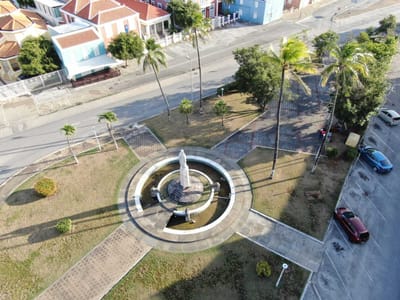QUEEN JULIANA

Juliana, April 30, 1909 – March 20, 2004, was Queen of the Netherlands from September 4, 1948 to April 30, 1980. The inauguration took place on September 6, 1948. Juliana is of great importance to Curaçao (Netherlands Antilles) because she signed the Statute, which marked the end of colonial relations within the Kingdom, in December 1954.
As a princess, she already visited Curaçao at the end of the Second World War. During the Wartime years, she stayed in Canada and London. That first visit to Curaçao took place from February 26 to March 5, 1944. A year earlier, she had already opened the airport – Princess Juliana Airport – on Sint Maarten.
At the beginning of the war, 2 days after the invasion of the Netherlands by Nazi Germany - on May 10, 1940 - Juliana fled with her family by boat to England. When Germany also threatened to invade England, she and her daughters left by boat for Canada on June 2. Her husband, Prince Bernhard, stayed behind with Queen Wilhelmina, Juliana's mother, in London. At the beginning of September 1944, Juliana returned to London at the request of her mother, but left for Canada again in January 1945. On August 2, 1945 she finally landed in the liberated Netherlands.
She was crowned Queen of the Netherlands on September 4, 1948 and visited Curaçao - for the first time as head of state - in 1955, a year after the signing of the Statute of the Kingdom. Two years later, her statue was unveiled in Curaçao, on Julianaplein, just steps away from the National Archives. In Curaçao she was portrayed as “mother of all nationals”. Juliana herself had no objection to being addressed as ma'am instead of majesty, it was even her preference. Juliana's looser style reduced the distance between the royal family and the people.
In 1955, the Island Council of Curaçao decided to design a statue of the young Queen Juliana. Much to the chagrin of Governor Teun Struycken, the commission went to the Venezuelan-Italian sculptor Renzo Bianchini. He would much rather have seen a Dutch sculptor receive such a commission. “It is probably cheaper too,” he wrote in April 1956 in a “personal p.s.” under a letter to the lieutenant governor.
A message in the Nieuwe Leidse Courant of July 26, 1956 sheds a completely different light on the origins of the image of Juliana. This indicates that this is a donation from the Venezuelan government as a tribute to the queen who meant so much to the development of Curaçao. Without further explanation, Jennifer Smit also mentions the island government of Curaçao as a 'probable client' in her overview of monuments. Venezuela's involvement is not unthinkable given the relations with the neighboring country at the time. In 1950, Prince Bernhard had made an extensive and warm friendly visit to this country, stressing its importance for the entire kingdom.
The statue that Bianchini made of Juliana is still there. The only adjustment the queen requested after seeing photos of the design was that she did not want to wear a diadem; the hair was allowed in a braid. A quote from Juliana from October 1955 is engraved on the pedestal: 'Coming together in freedom is the cornerstone of every real collaboration', which illustrates the ideals, optimism and hope of the 1950s.
The statue has also been the subject of protest over the years. In 1960 it was smeared with paint by 5 men, apparently aimed against the Constitutional Kingdom Association for which the Queen stood
as a symbol. Ten years later the statue was used again as a protest. On February 10, 1970, Amigoe reported that 'miscreants' had smeared the statue of Queen Juliana with a call to the recently appointed plenipotentiary minister Efraïn Jonckheer to return to Curaçao.
Elis Juliana, born in “Nieuw Nederland”, the city district through which this walking tour passes. (subtitle)
about for example, the development of the Guene language as a precursor to Papiamentu, about folk religion and resistance to slavery. Brenneker combined his love for local culture with charity. He did the latter specifically through the foundation for the homeless, Kas Pa nos Tur (a house for everyone), and the foundation Pan Pa mi Ruman (bread for my brothers and sisters) for people who are suffering from hunger.


